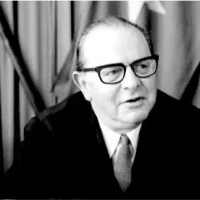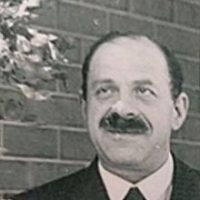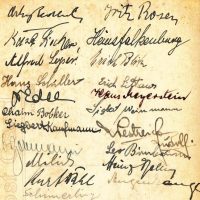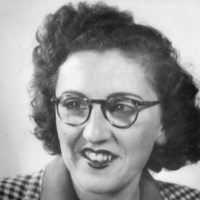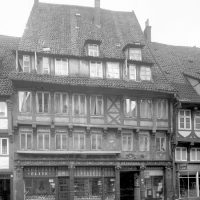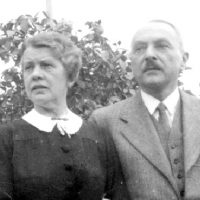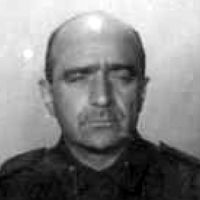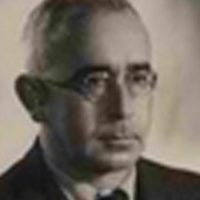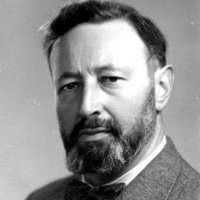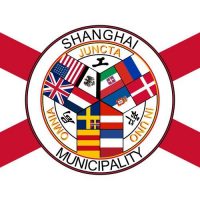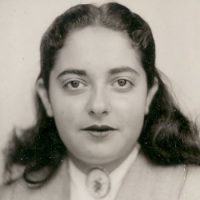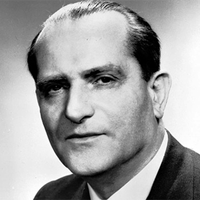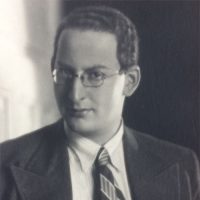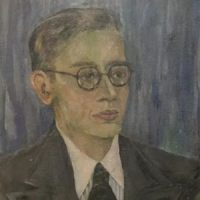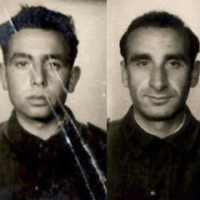Of the members of the Flieder family known to us, only my mother Ida was able to survive the Nazi era. Her parents and all her siblings were murdered. The different fates symbolise the last phases of life that became part of the Holocaust. In addition to the oral traditions of my parents, the files left behind by Ida and Heinz Dehn on restitution and compensation for the crimes committed by the Nazis against family members were the starting point for further research.
Peter Dehn January 2024
The Flieders – Polish Jews in Hanover
The Flieder family has its roots in Warsaw. Abraham (Adam) Flieder[1] No documents are available for the birth dates of Abraham and his wives Chaja and Rosa. The information is derived from other official documents. was born on 12 February 1873 in Warsaw. His first marriage was to Chaja Feferberg (Pfefferberg), born in Cmielow (Poland) in 1881. Their son Izrael was born in Warsaw on 15 November 1907, his brother Majer Lajb on 10 January 1910. The successive entries also state that the “already deceased wife Haja, née Feferber” is their mother.
The registry office birth entries of the two sons are interesting not only because the books were kept in Russian[2] After the Congress of Vienna 1815, the Kingdom of Poland was ruled by the Russian Tsar. This changed only when Russia withdrew in 1915 after a military defeat. at the time. Accordingly, the date is recorded according to both the Julian calendar used in Russia and the Gregorian calendar[3] All dates mentioned here according to the Gregorian calendar. used in Europe.
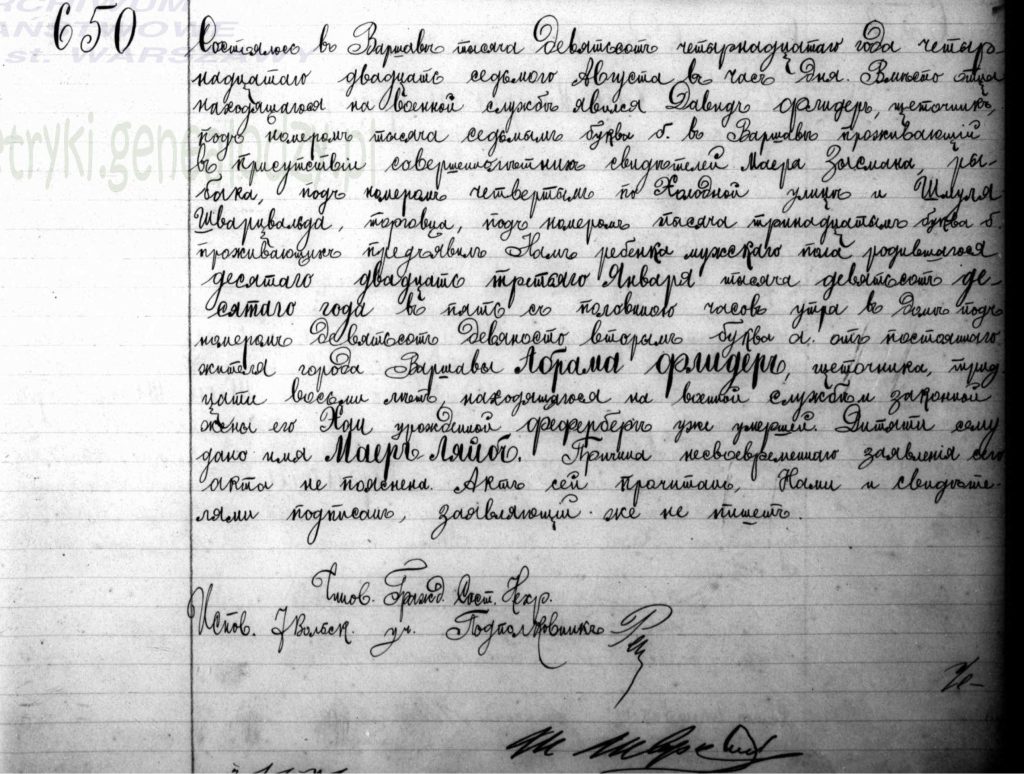
What is even more interesting is that both notifications are only submitted to the office on 14 August 1914[4] Archivum Panstwowe Warszawa, birth entreis no. 649 and 650. Translated from Russian by Maria Martynowa. by the brush maker David Flieder. No reasons are given for the years-long delay in reporting. The absence of the father, Abraham Flieder, is attributed to his service in the army.
Was David Flieder, also a brush maker, Abraham’s brother? This cannot be proven. Did Chaja die shortly after the birth of his second son? What happened to Majer Lajb? Unfortunately, no further information is available.
Idas parents Abraham and Ruchla
Ruchla (Rosa) Hoffer was born in Warsaw on September 1, 1882. No information is available about her parents and siblings. In a Belgian document Izrael Flieder mistakenly[5] This was a mistake on Izrael's part. However, a relationship of Ruchla with a Polish-Jewish family Rozenfeld in Paris is suspected, but not proven. gives her birth name as “Rozenfeld”, which takes on meaning elsewhere.
nder what circumstances Abraham Flieder and Ruchla Hoffer met and when and where they married is not known. She is – already as the wife of Abraham Flieder – registered in Hannover from November 12, 1917. He is said to have arrived there already on January 27, 1917, coming from Holzminden. Another source gives March 15, 1918 as the date of arrival in Hannover for both of them. So, either way, this is before the end of World War 1 and the proclamation of Polish independence on October 7, 1918. So, Abraham is not a soldier of the army of Poland shifted back and forth between Russia and Germany, revolution and reaction.
Abraham and Ruchla have three children. Chin (Simon) is born in 1919, Ida in 1921 and Isaac in 1922. Like their parents, all are Jews and Polish citizens. Abraham gives the profession of brush maker for address books and official records. As Ida reported, however, he is unable to pursue this occupation for health reasons. How the family’s livelihood is financed remains unknown. The family lives on the 3rd floor of Marktstraße 38, in a half-timbered house with an unusually raised roof built in the 16th century.
Polish Jews among the first victims
Anti-Semitism, which becomes a state doctrine shortly after the Nazis take power, already deeply intervenes in many areas of the everyday life of Jewish people since 1933. Abraham and Isaac become victims of the so-called 1st “Polenaktion“: On October 28, 1938, 17,000 Polish Jews throughout Germany are arrested and shipped to the Polish border in a well-prepared action that takes the victims by surprise. They are allowed to take hardly any luggage with them. There they are pushed into no man’s land by armed men with bayonets fixed. This happens to the largest group near Bentschen (Zbaszyn; Poznan Voivodeship). Polish authorities hurriedly set up a camp where father and son were accommodated. Ruchla Flieder puts together a clothing package for both of them, which is approved for shipment to Zbaszyn on November 15, 1938. Abraham, in poor health, dies there on January 29, 1939. Izrael brings his 18-year-old half-brother Isaak to Belgium soon after.
“Around May 1939, my mother wrote me from Hanover to Australia that she would probably now have to go on a trip, too.” This is what Ida tells a court as the last message[6] Testimony of Ida Dehn. Berlin Schöneberg Local Court, file 77 AR 310.58, minutes of April 24, 1958. Lower Saxony State Archives, file nds_725_Hannover_acc._103-96_nr._2656. Ida received from her relatives. Ruchla and the eldest son Simon are deported to the neighboring country on June 23, 1939, in the course of the second[7] Central Office for Welfare of the Hanover Synagogue Community to the Foreign Exchange Office of the Hanover Regional Finance Directorate (OFD) on July 6, 1939. In the main archive of Lower Saxony ha_nds._hann._210_acc._2004_025_nr._4782, sheet 4. “Polenaktion”. As early as July 6, a Mrs. Goldberg[8] Answer of OFD to Zentralstelle from July 7, 1939, ibid. Sheet 5f. is appointed as “overall trustee for the domestic assets of Polish citizens deported to Poland”. The Chief Finance Office asks her to liquidate the property of the Flieder family by the end of September 1939.
On September 1, 1939, the Nazis begin World War 2 with the invasion of Poland, their anti-Semitism again threatening the lives of the deported Jews even more than before.
On May 15, 1940, the Welfare Office of the Jewish Synagogue Community of Hanover lists some of Ruchla’s property remaining in Hanover for forwarding. A package of clothing, shoes, etc. is to be sent to Ruchla Flieder in Warsaw, Karmelicka 17/23 c/o Salzmann[9] The address is in the center of Warsaw, in the area of 6the ghetto that was establieshed at the beginning of October, whre zo to 500,000 people were crammed together. Cf. Wikipedia about the Warsaw ghetto (German) , retrieved June 30, 2023.. Also listed are suits, nightgowns and other items of clothing expressly for men; it can therefore be assumed that Simon is with his mother. The authorities approve the transfer on May 17, 1940. The forwarding of a second package[10] Correspondence Zentralstelle/OFD after Juy 7, 1939, ibid sheets 12ff. of clothing is prohibited by the Nazi authorities on July 19, 1940.
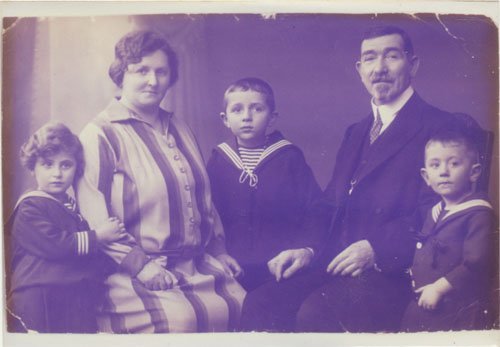
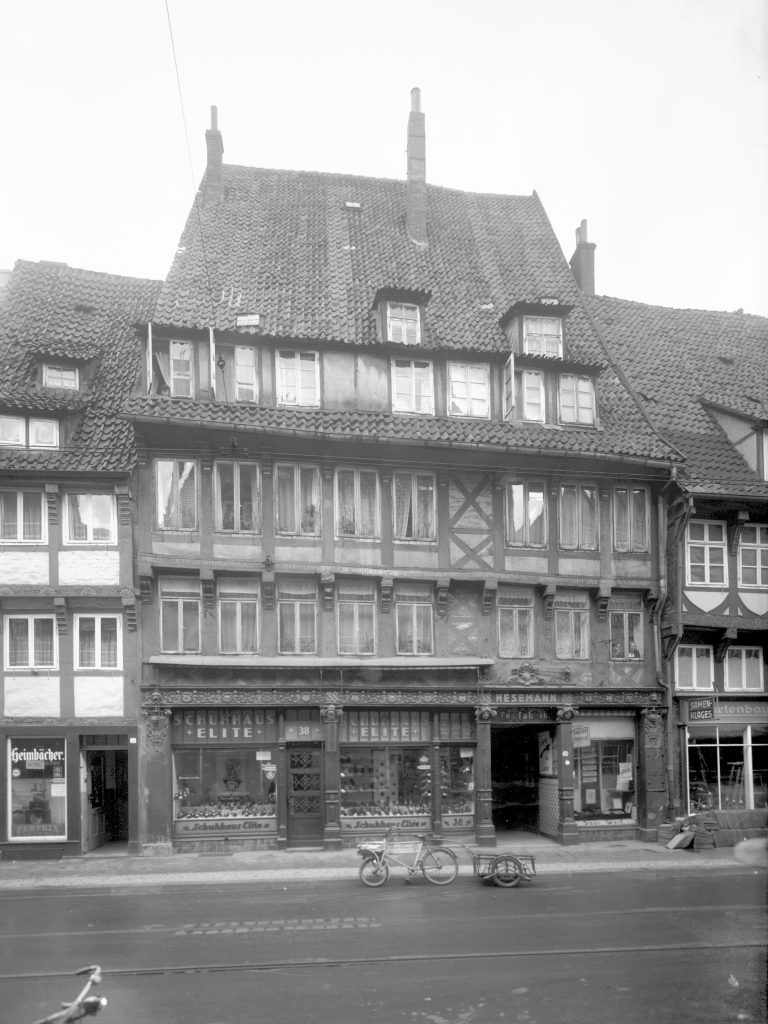

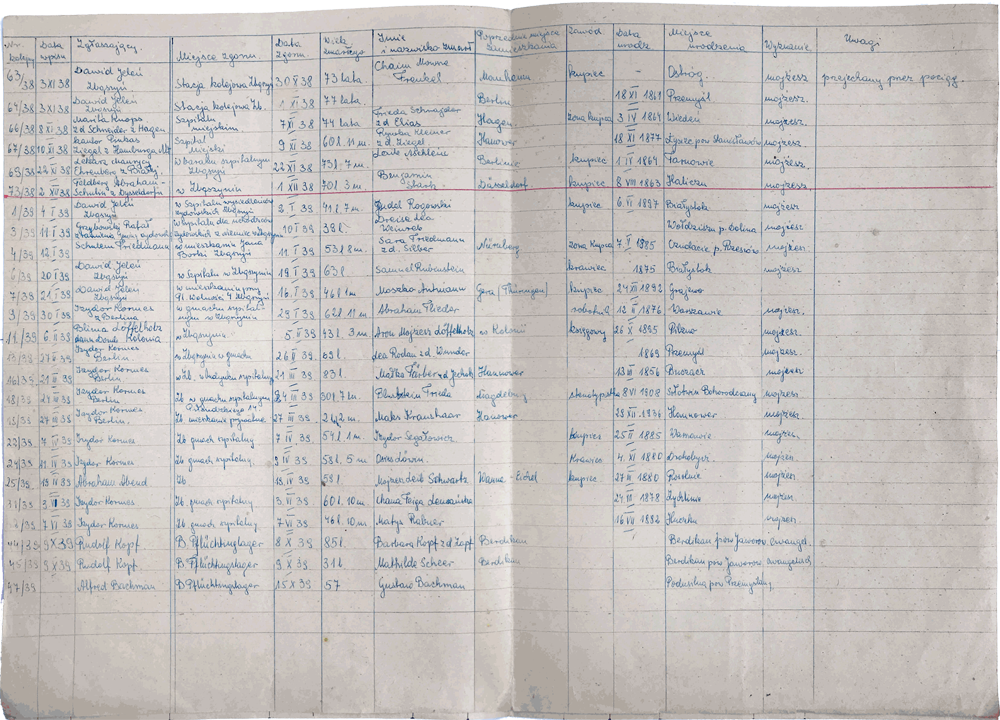
Apprenticeship in Munich: Ida’s older brother Chin (Simon)
Simon (Chin) is the elder son of Ruchla and Abraham Flieder. He is born on New Year’s Eve 1919 in Hanover. At the age of 14 he goes to Munich. From May 7, 1934 he lives in the “isr. Lehrl. Heim” (israelite apprentice residential home) in the Wagnerstraße[11] Registry office Munich, index card.. This moved to Hohenzollernstrasse 4 on July 28, 1937. The home is connected to the Jewish apprentice workshop on Biederstein Street. Simon learns the profession of carpenter there. In 1938/39, 91 apprentices, including locksmiths, are trained there. In addition to the practical part, they receive 12 to 15 hours of instruction a week in subjects such as arithmetic, tools and materials, technical drawing, bookkeeping, business correspondence and economics. However, the Nazi authorities only permit examinations if the graduates leave Germany immediately. The graduation certificates[12] Cf.„Jüdische Anlernwerkstätten“, Gedenkbuch online muenchen.de (German), retrieved June 30, 2023. therefore have to be supplemented with the words “Zeugnis für Auswanderer” (Certificate for Emigrants).
The workshop is destroyed by the Nazis in December 1938. Vocational training has to be interrupted until the institution can operate provisionally again in a synagogue destroyed by the Nazis. In 1942, the Gestapo closes the training workshop completely and distributes machines etc. to “Aryan” institutions.
As of December 12, 1938, Simon is again registered in Hanover, where his mother Ruchla lives alone and probably without income after the 1st “Polenaktion”. Simon returns to Hanover just in time to say goodbye to his sister Ida, who officially deregisters Hanover for her escape to Australia on December 12, 1938. Ruchla and Simon are recorded as Jews at Marktstraße 38 in the census on May 17, 1939[13] Cf. Mapping the lives, Data of the census on May 17, 1939, retrieved July 10, 2023.. All that is known about Simon is that he – like his mother – is deported to Poland during the 2nd “Polenaktion” on June 23, 1939.
In the Warsaw Ghetto, established in October 1940, the traces of Ruchla and Simon are lost. Starting in July 1942, the SS began mass deportations of ghetto residents to the Treblinka death camp. In April and May 1943, the remaining Jews revolt against the threat of extermination. Their uprising was bloodily put down on May 16, 1943. The “total number of Jews captured and verifiably exterminated is 56,065,” SS Brigadeführer Stroop[14] Cf. Wladyslaw Bartoszewski „Das Warschauer Ghetto – Wie es wirklich war. Zeugenberichte eines Christen“. Frankfurt am Main 1986, page 106; Philip Friedman „Im Ghetto von Warschau“ in „Der Zweite Weltkrieg Band 2: Von Pearl Harbor bis Stalingrad“, Stuttgart 1989, page 126. Wikipedia (German) about the Warsaw ghetto, loc.cit. proudly reports upward.
Izrael Flieder starts a family in Belgium
Izrael Flieder[15] Archivum Panstwowe Warszawa, entry no. 649. also lives with the family in Hanover for a time. When Abraham came to Hanover in 1918, his son from his first marriage was only eleven years old. Later he learns the trade of a tailor and is registered in his parents’ house at Marktstraße 38 until April 21, 1926. The next information about him is dated December 28, 1926 from Belgium. Until February 1927 he lives there in a homeless shelter. He gets a job as a tailor with Wolf Steinberg in Antwerp and is then able to apply for a permanent residence permit.
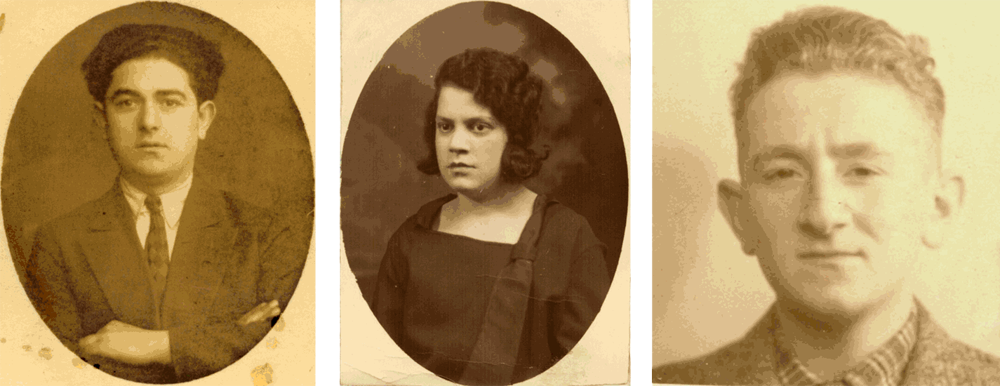
His first own apartment is until June 24, 1927 in the Somerstraat 12. Later he moves to Brussels[16] Cf. Izrael Flieder 88page files by the Belgian immigration police. Museum Kazerne Dossin file KD_00014_510_0841_000_1463860_000. for subletting in the rue des quatre Vents 11 c/o Bétremieux.
When Izrael marries cannot be inferred from the otherwise meticulous collection of material by the Belgian Aliens Police. His wife, Hena Pacierkowska, was born in Kielce (Poland) on July 15, 1907, and is a trained seamstress. Chaim Majer Pacierkowski[17] Application by Chaim Majer Pacierkowski Nov 11, 1929. Dehn family archive., Hena’s brother born in 1898, applies for an entry visa for her on October 31, 1929. He is looking for help in the household because his wife is ill and because their two children also urgently need care. He is also from Kielce and has been working at the leather goods company Warchavski&Waserstrum in Brussels since 1928.
Izrael‘s and Hena’s son Max was born on June 19, 1934 in Laeken, a northern district of Brussels. After the Nazi occupation of Belgium, their last address in Brussels is in the Molenbeek-Saint-Jean district, Rue de Ribaucourt 14.
From Poland to Belgium: Isaak Flieder
At the end of January 1939, Isaak Flieder[18] Registry office Hanover, birth record no. 2918, Sep 28, 1922., born in Hanover on September 22, 1922, as the youngest child of the Flieder family, is faced with nothing in Zbaszyn. After his father Abraham died there, the 16-year-old is left to fend for himself. His half brother Izrael brings him to Belgium. The Jewish Craftsmen’s Association of Belgium[19] Letters by Union des Artisans Juifs an Securete of March 27, 1939 and April 13, 1939. provides valuable support. The association explains to the Belgian authorities that Isaak’s mother cannot provide for him sufficiently in Hanover. On the other hand, Isaak’s further education and livelihood would be secured in Belgium. Isaak receives the visa.
He first travels from Zbaszyn to Hanover to complete his luggage and see his mother. The things he wants to take with him – clothes, bedclothes, watch, camera, prayer belt, prayer shawl, prayer books, etc. – he has to get approved by the authorities[20] Main archive Lower saxony, file ha_nds._hann._210_acc._2004_025_nr._3607.. On June 7, 1939, he asks for a speedy completion because of the time pressure. On June 14, Simon’s request for 23 Reichsmark travel money is approved. On June 15, the customs authorities determine that neither “means of payment, securities, gold or precious metals” are in the two suitcases presented there. His deregistration from Hanover and registration in Belgium are dated June 15, 1939. A week later he would probably have been deported to Poland, like his mother and brother Simon in the course of the 2nd “Polenaktion” on June 23.
Isaak’s first address in Belgium is at 37 rue Camusel, which had also been Hena’s first residence in 1930. Later he goes to Charleroi[21] Cf. Isaak Flieder files, Belgian immigration police. Museum Kazerne Dossin file KD_00014_510_0841_000_7346370_000_0.. He lives first with Lebrun at rue Grande 148 and then in the house number 14, Boulevard Paul Janson.
The Fate of the Jews in Belgium
The security in which the refugees believed themselves in neutral Belgium proved to be deceptive. For two weeks after the beginning of the attack by the Nazi armed forces, Belgium capitulates on May 28, 1940. Soon, anti-Semitic restrictions on everyday life are also introduced in the neighboring country. By the time of liberation in 1944, 26,000 of the 100,000 Jews in the country are deported by the fascists and murdered in death camps.[22] Cf. „Jüdisches Leben in Brüssel“, (Jewish life in Brussels; in German), retrieved June 25, 2023. Many upright people help despite the threat: they hide Jews, give them food or help them escape. But this is not possible for everyone.
Isaak Flieder “voluntarily” follows the „Arbeitseinsatzbefehl“ AB 002110 (work assignment order) at the end of July 1942 and reports to the former barracks near Mechelen (French: Malines). This is a deception, as the SS uses the site as a collection and transit camp for transports to extermination camps. Isaak is deported to the East on August 4, 1942 with the first transport as No. 680. The 998 Jewish people on this transport reach Auschwitz after a two-day train ride. 254 are gassed immediately. Of the 744 Jews forced into labor, nine were still alive[23] Mail Museum Kazerne Dossin to Peter Dehn, March 3, 2021. at the time of liberation in 1945. In the death books of the extermination camp, Isaak Flieder’s death is noted on September 25, 1942. The recorded cause of death – after only about 6 weeks in the camp – is indicative of the extermination of human beings by the fascists and cynically reads: “intestinal catarrh due to physical weakness[24] International Red Cross Tracking Service to Ida Dehn, Nov 24, 1958. Dehn family archive.“.
The path of his half-brother Izrael and his family also leads to death via the Kazerne Dossin collection camp. They were imprisoned on July 7, 1943. From Kazerne Dossin, the XXI transport is sent to Auschwitz on July 31, 1943. 1,087 of the 1,553 deportees from Belgium were immediately gassed. Izrael, Hena and Max “disappeared without leaving a trace”, so that the exact date of their deaths[25] Mail Museum Kazerne Dossin ibid. remains unknown. This possibly also because the Nazis destroyed many documents before their escape. Only 44 people from this transport live to see the liberation of the death camp.
Reparation and compensation
The example of the Flieder family also shows how German authorities try to systematically obstruct payments in matters of reparation and compensation. Among other things, Ida Dehn has to prove succession according to Polish law in order to justify her claims as the sole heir of her family members. After all, Polish Jews are not Germans, even if born in Germany like Ida and her brothers. In addition, the court temporarily involves a trustee in the proceedings pursued by Ida Dehn. The trustee cannot make a significant contribution to the case, but her work leads to delays in processing and costs money.
Please note: Unless otherwise stated, the sources cited are part of the Dehn family archive.
Footnotes
show
- [1]↑No documents are available for the birth dates of Abraham and his wives Chaja and Rosa. The information is derived from other official documents.
- [2]↑After the Congress of Vienna 1815, the Kingdom of Poland was ruled by the Russian Tsar. This changed only when Russia withdrew in 1915 after a military defeat.
- [3]↑All dates mentioned here according to the Gregorian calendar.
- [4]↑Archivum Panstwowe Warszawa, birth entreis no. 649 and 650. Translated from Russian by Maria Martynowa.
- [5]↑This was a mistake on Izrael's part. However, a relationship of Ruchla with a Polish-Jewish family Rozenfeld in Paris is suspected, but not proven.
- [6]↑Testimony of Ida Dehn. Berlin Schöneberg Local Court, file 77 AR 310.58, minutes of April 24, 1958. Lower Saxony State Archives, file nds_725_Hannover_acc._103-96_nr._2656.
- [7]↑Central Office for Welfare of the Hanover Synagogue Community to the Foreign Exchange Office of the Hanover Regional Finance Directorate (OFD) on July 6, 1939. In the main archive of Lower Saxony ha_nds._hann._210_acc._2004_025_nr._4782, sheet 4.
- [8]↑Answer of OFD to Zentralstelle from July 7, 1939, ibid. Sheet 5f.
- [9]↑The address is in the center of Warsaw, in the area of 6the ghetto that was establieshed at the beginning of October, whre zo to 500,000 people were crammed together. Cf. Wikipedia about the Warsaw ghetto (German) , retrieved June 30, 2023.
- [10]↑Correspondence Zentralstelle/OFD after Juy 7, 1939, ibid sheets 12ff.
- [11]↑Registry office Munich, index card.
- [12]↑Cf.„Jüdische Anlernwerkstätten“, Gedenkbuch online muenchen.de (German), retrieved June 30, 2023.
- [13]↑Cf. Mapping the lives, Data of the census on May 17, 1939, retrieved July 10, 2023.
- [14]↑Cf. Wladyslaw Bartoszewski „Das Warschauer Ghetto – Wie es wirklich war. Zeugenberichte eines Christen“. Frankfurt am Main 1986, page 106; Philip Friedman „Im Ghetto von Warschau“ in „Der Zweite Weltkrieg Band 2: Von Pearl Harbor bis Stalingrad“, Stuttgart 1989, page 126. Wikipedia (German) about the Warsaw ghetto, loc.cit.
- [15]↑Archivum Panstwowe Warszawa, entry no. 649.
- [16]↑Cf. Izrael Flieder 88page files by the Belgian immigration police. Museum Kazerne Dossin file KD_00014_510_0841_000_1463860_000.
- [17]↑Application by Chaim Majer Pacierkowski Nov 11, 1929. Dehn family archive.
- [18]↑Registry office Hanover, birth record no. 2918, Sep 28, 1922.
- [19]↑Letters by Union des Artisans Juifs an Securete of March 27, 1939 and April 13, 1939.
- [20]↑Main archive Lower saxony, file ha_nds._hann._210_acc._2004_025_nr._3607.
- [21]↑Cf. Isaak Flieder files, Belgian immigration police. Museum Kazerne Dossin file KD_00014_510_0841_000_7346370_000_0.
- [22]↑Cf. „Jüdisches Leben in Brüssel“, (Jewish life in Brussels; in German), retrieved June 25, 2023.
- [23]↑Mail Museum Kazerne Dossin to Peter Dehn, March 3, 2021.
- [24]↑International Red Cross Tracking Service to Ida Dehn, Nov 24, 1958. Dehn family archive.
- [25]↑Mail Museum Kazerne Dossin ibid.
